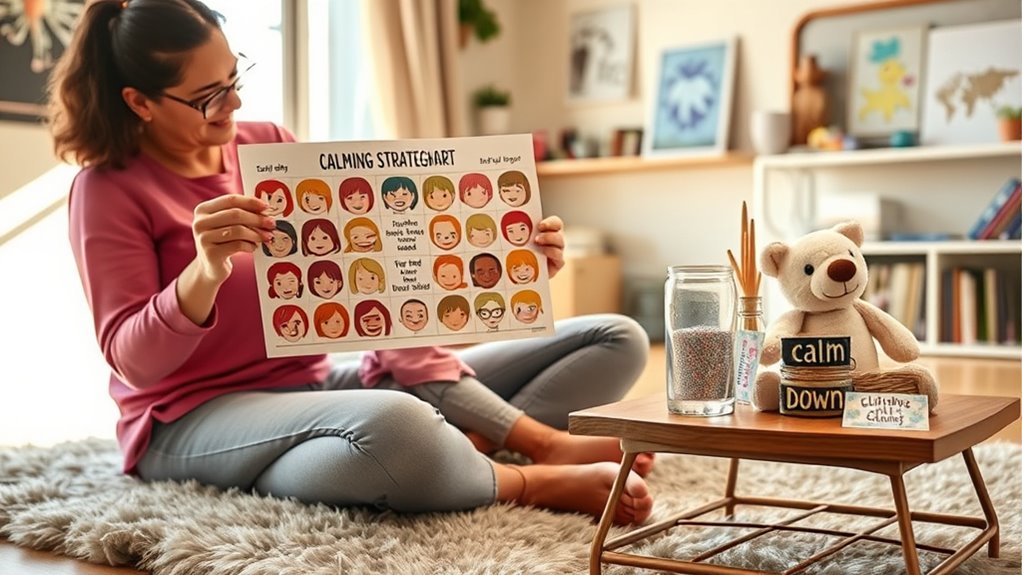To build an emotion coaching toolkit for any meltdown, start by practicing active listening and empathy to validate feelings without rushing to fix problems. Incorporate stress management techniques like deep breathing and grounding exercises to stay calm yourself. Recognize emotional triggers early and prepare calming strategies, such as taking breaks or suggesting calming activities. With patience and consistent practice, you’ll develop confidence in guiding emotions smoothly—keep exploring to discover more effective strategies for every situation.
Key Takeaways
- Develop active listening skills to validate feelings without immediately attempting to fix the problem.
- Prepare calming strategies, such as deep breathing or grounding exercises, tailored to individual triggers.
- Recognize emotional triggers and plan proactive approaches to diffuse escalation early.
- Incorporate empathy and patience to create a safe space for emotional expression and regulation.
- Practice consistent responses and reflection to strengthen trust and improve emotional resilience over time.

Understanding and managing emotions is indispensable for healthy relationships and personal well-being, yet many people feel unprepared to do so effectively. When a meltdown occurs, it’s natural to feel overwhelmed or unsure of how to respond. Building an emotion coaching toolkit gives you the tools needed to navigate these moments with confidence. At the core of this toolkit is empathy development—your ability to genuinely understand and validate what someone else is feeling. Empathy doesn’t mean fixing the problem immediately; it means being present, listening actively, and acknowledging their emotions without judgment. Practice reflective listening, where you paraphrase what you hear, so the other person feels truly understood. This simple step can de-escalate intense feelings and create a safe space for expression.
Empathy and active listening help de-escalate emotions and foster a safe space for expression.
Alongside empathy, stress management techniques are essential. When emotions run high, it’s easy to get caught up in the chaos, which hampers your ability to respond thoughtfully. Developing your own stress management strategies—like deep breathing, grounding exercises, or quick mindfulness practices—can help you stay calm and centered during a meltdown. For instance, taking a few slow, deep breaths can reduce your physiological response to stress, allowing you to approach the situation with clarity. Grounding exercises, such as feeling your feet on the ground or touching a textured object, anchor you in the present moment and prevent escalation. Incorporating these techniques into your daily routine builds resilience, so you’re better prepared when emotional storms hit. Recognizing the importance of portable tools, like portable camping gear, can also inspire adaptable strategies for managing emotions in various environments.
Additionally, understanding emotional triggers helps you anticipate and diffuse potential meltdowns before they escalate. Pay attention to patterns—what situations or topics tend to set off strong reactions? Recognizing these allows you to approach sensitive moments with extra patience and empathy. Equally important is having a repertoire of calming strategies you can offer, like suggesting a break or engaging in a calming activity together. Remember, your goal isn’t to suppress emotions but to guide them constructively. This means validating feelings while gently encouraging regulation and reflection.
Finally, patience and consistency are indispensable. Building an emotion coaching toolkit isn’t a one-time effort but an ongoing process. The more you practice empathy development and stress management techniques, the more natural they become. Over time, your responses will foster trust and emotional safety, transforming challenging moments into opportunities for connection and growth. By equipping yourself with these skills, you create a supportive environment where emotions are managed with care and understanding, making any meltdown moment more manageable and less stressful.
Frequently Asked Questions
How Do I Handle My Own Emotions During My Child’s Meltdown?
During your child’s meltdown, focus on your emotional regulation by practicing self-care strategies like deep breathing or pausing before reacting. Stay calm and remind yourself that their emotions are valid. Taking care of your own feelings helps you respond more effectively. Remember, managing your emotions isn’t selfish; it’s essential. When you stay centered, you model healthy coping, which benefits both you and your child during challenging moments.
What Are Quick Calming Techniques for High-Stress Moments?
Did you know that simple breathing exercises can reduce stress within minutes? During high-stress moments, try deep, slow breaths to calm your nerves. Incorporate sensory tools like textured fabrics or calming scents to ground yourself quickly. These techniques are effective because they engage your senses and regulate your nervous system, helping you stay composed and centered, even in intense situations. Practice them regularly to make calmness your default response.
How Can I Tailor My Toolkit for Different Age Groups?
To tailor your toolkit for different age groups, focus on age-appropriate strategies that match developmental considerations. For young children, use simple language, visuals, and comforting techniques. For older kids, incorporate conversations that validate feelings and encourage problem-solving. Adjust your approach based on their emotional maturity and cognitive skills, ensuring each method resonates with their developmental stage. This personalization helps you connect effectively during meltdown moments.
What if My Child Refuses Comfort or Coaching?
When your child resists comfort or coaching, remember it’s not the end of the world. Parent resistance and comfort resistance can be tough, but it’s important to stay patient. Sometimes, kids just need space before they’re ready to open up. Keep offering support without pressure, knowing that pushing too hard might backfire. Trust that, with time, they’ll be more receptive as their feelings become clearer to them.
How Do I Introduce Emotion Coaching to Reluctant Children?
When introducing emotion coaching to reluctant children, you can start by modeling emotional literacy yourself. Show how you recognize and name your feelings openly, which encourages them to do the same. Use simple, relatable language and stay calm, demonstrating that emotions are okay to express. Over time, your consistent parental modeling helps your child feel safe exploring their feelings, making them more receptive to coaching and understanding their emotions better.
Conclusion
By creating your own emotion coaching toolkit, you’re equipping yourself to handle meltdowns with confidence and compassion. Remember, research shows that children whose parents use emotion coaching are 30% more likely to develop strong emotional regulation skills. Keep your toolkit handy, stay patient, and approach each meltdown as an opportunity to teach and connect. With these tools, you’ll foster resilience and trust, making challenging moments easier for both of you.










